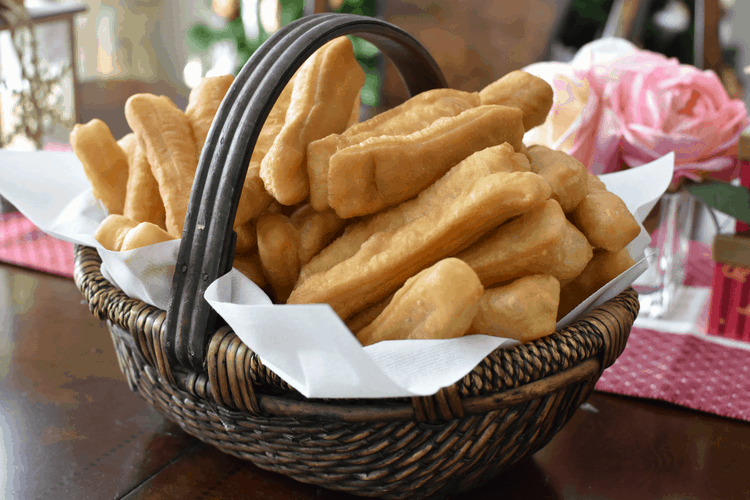Patongo is a crispy and hollow Chinese Donut. Chinese people call them youtiao or char kuay. They are common in many Asian countries and have many different names. They look more like breadsticks and is kind of like a Chinese fried churro. Lao people enjoy these delicious fried pastries in their kao piek sen (chicken noodle soup), porridge or for breakfast with coffee. My favorite way of eating it is to dip it in condensed milk. As with anything that is deep fried, these crispy hollow bread sticks are best when they are made fresh.
Making The Dough
The ingredients are quite simple as they’re made with self raising flour, eggs, water, salt and oil. The process to make patongo however, takes time. First make a well in the flour. Add an egg, water, salt and oil into the middle.
Then you slowly incorporate the flour into the center with your hand. Make sure you break the egg and mix it well into the mixture. Slowly, a dough will form. Knead the dough and sprinkle it with a little more flour as you knead. This prevents the dough from sticking. Knead the dough until it is smooth and doesn’t stick to your hand for about 8 minutes.
Place the dough on a chopping board sprinkled with flour. Then let it rest for 45 minutes covered with a dry kitchen towel. Then place a damp kitchen towel over the dry one.
Assembling the Patongo
To assemble, press the dough down to about about 2.5cm thickness. Cut off 5cm of the dough and gently roll it out until it’s long and about 0.5cm thickness. Then with a knife, cut the dough into 2cm wide pieces. You want to make sure you have an even number so you can pair them up. With a wooden skewer, dip it into some water then press the skewer onto the top of the dough. This will bind the two pieces together.
Frying the Patongo
To fry the patongo, you want the oil to be hot but not too hot. Have the heat on medium. Before you drop the patongo into the oil, hold the center of the dough and then gently pull. Once you see the dough floating to the surface and expanding, gently flip the patango. Continue to flip them to get them to brown evenly. Fry until they become golden brown and place them on paper towel to drain the excess oil.
The patongo should be crispy on the outside and hollow on the inside. Enjoy them with condense milk, kao piak sen or rice porridge. I can guarantee you that you’ll have more than one!
Patongo is fried breadsticks that originated in China. These delicious breadsticks can be found in many Asian countries.
- 2.2 lb self raising flour sifted
- 1 whole egg
- 1/4 tsp salt
- 1 T vegetable oil
- 650 mls water room temperature
-
Put the flour in a big mixing bowl and make a well.
-
Add the egg, salt, oil and water in the middle.
-
Use you hand to break up the egg and mix it into the water, salt and oil.
-
Slowly incorporate the flour into the center as you mix.
-
Once you see the dough forming, start kneading it. Sprinkle more flour on the dough to prevent sticking.
-
Knead for about 8 minutes until the dough is smooth and it doesn't stick to your hand.
-
Remove the dough onto a chopping board sprinkled with flour.
-
Cover the dough with a dry kitchen towel. Then cover the dry kitchen towel with a damp kitchen towel. Let it sit for 45 minutes.
-
Remove the towels and press the dough down to about 5cm.
-
Cut about 5cm of the dough and roll it out to about 1cm thick.
-
Then cut that piece into 2cm wide pieces. Make sure you have an even number of pieces so they create a pair.
-
Place the dough pieces on top of each other. Dip a wooden skewer into water and press down on the dough pairs. This will keep the pair together.
-
Heat the vegetable oil on medium. Before placing in the oil, gently pull the dough from the center.
-
When the dough starts to enlarge, slowly flip the patango. Continue to flip continuously until the become nice golden brown. Drain excess oil on paper towels.
